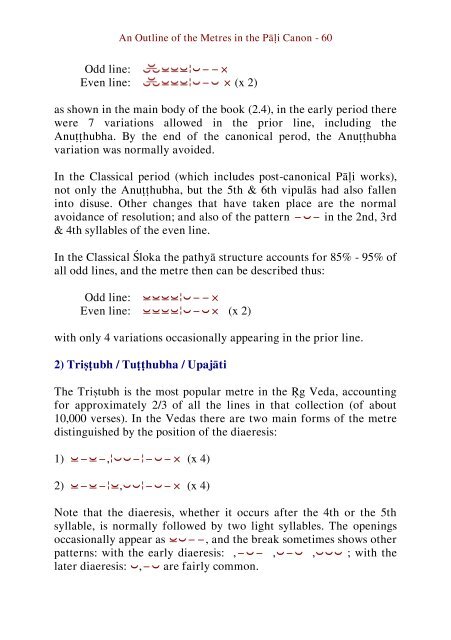An Outline of the Metres in the Pāḷi Canon
A concise but thorough explanation of the metres that are found in the Pāli canon, along with examples and glossary.
A concise but thorough explanation of the metres that are found in the Pāli canon, along with examples and glossary.
You also want an ePaper? Increase the reach of your titles
YUMPU automatically turns print PDFs into web optimized ePapers that Google loves.
<strong>An</strong> <strong>Outl<strong>in</strong>e</strong> <strong>of</strong> <strong>the</strong> <strong>Metres</strong> <strong>in</strong> <strong>the</strong> <strong>Pāḷi</strong> <strong>Canon</strong> - 60<br />
Odd l<strong>in</strong>e: ⏓¦⏑−−×<br />
Even l<strong>in</strong>e: × (x 2)<br />
as shown <strong>in</strong> <strong>the</strong> ma<strong>in</strong> body <strong>of</strong> <strong>the</strong> book (2.4), <strong>in</strong> <strong>the</strong> early period <strong>the</strong>re<br />
were 7 variations allowed <strong>in</strong> <strong>the</strong> prior l<strong>in</strong>e, <strong>in</strong>clud<strong>in</strong>g <strong>the</strong><br />
<strong>An</strong>uṭṭhubha. By <strong>the</strong> end <strong>of</strong> <strong>the</strong> canonical perod, <strong>the</strong> <strong>An</strong>uṭṭhubha<br />
variation was normally avoided.<br />
In <strong>the</strong> Classical period (which <strong>in</strong>cludes post-canonical <strong>Pāḷi</strong> works),<br />
not only <strong>the</strong> <strong>An</strong>uṭṭhubha, but <strong>the</strong> 5th & 6th vipulās had also fallen<br />
<strong>in</strong>to disuse. O<strong>the</strong>r changes that have taken place are <strong>the</strong> normal<br />
avoidance <strong>of</strong> resolution; and also <strong>of</strong> <strong>the</strong> pattern −⏑− <strong>in</strong> <strong>the</strong> 2nd, 3rd<br />
& 4th syllables <strong>of</strong> <strong>the</strong> even l<strong>in</strong>e.<br />
In <strong>the</strong> Classical Śloka <strong>the</strong> pathyā structure accounts for 85% - 95% <strong>of</strong><br />
all odd l<strong>in</strong>es, and <strong>the</strong> metre <strong>the</strong>n can be described thus:<br />
Odd l<strong>in</strong>e: ⏓⏓⏓⏓¦⏑−−×<br />
Even l<strong>in</strong>e: ⏓⏓⏓⏓¦⏑−⏑× (x 2)<br />
with only 4 variations occasionally appear<strong>in</strong>g <strong>in</strong> <strong>the</strong> prior l<strong>in</strong>e.<br />
2) Triṣṭubh / Tuṭṭhubha / Upajāti<br />
The Triṣtubh is <strong>the</strong> most popular metre <strong>in</strong> <strong>the</strong> Ṛg Veda, account<strong>in</strong>g<br />
for approximately 2/3 <strong>of</strong> all <strong>the</strong> l<strong>in</strong>es <strong>in</strong> that collection (<strong>of</strong> about<br />
10,000 verses). In <strong>the</strong> Vedas <strong>the</strong>re are two ma<strong>in</strong> forms <strong>of</strong> <strong>the</strong> metre<br />
dist<strong>in</strong>guished by <strong>the</strong> position <strong>of</strong> <strong>the</strong> diaeresis:<br />
1) ⏓−⏓−,¦⏑⏑−¦−⏑−× (x 4)<br />
2) ⏓−⏓−¦⏓,⏑⏑¦−⏑−× (x 4)<br />
Note that <strong>the</strong> diaeresis, whe<strong>the</strong>r it occurs after <strong>the</strong> 4th or <strong>the</strong> 5th<br />
syllable, is normally followed by two light syllables. The open<strong>in</strong>gs<br />
occasionally appear as ⏓⏑−−, and <strong>the</strong> break sometimes shows o<strong>the</strong>r<br />
patterns: with <strong>the</strong> early diaeresis: ,−⏑− ,⏑−⏑ ,⏑⏑⏑ ; with <strong>the</strong><br />
later diaeresis: ⏑,−⏑ are fairly common.

















